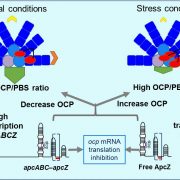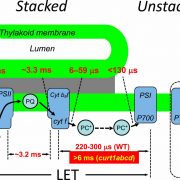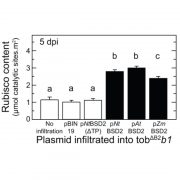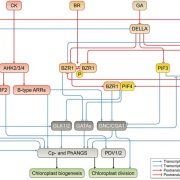Update: The impacts of fluctuating light on crop performance
By
Abstract
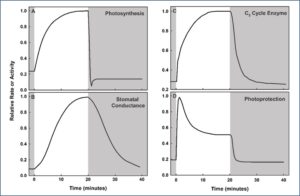 Rapidly changing light conditions can reduce carbon gain and productivity in field crops because photosynthetic responses to light fluctuations are not instantaneous. Plant responses to fluctuating light occur across levels of organizational complexity from entire canopies to the biochemistry of a single reaction and across orders of magnitude of time. Although light availability and variation at the top of the canopy are largely dependent on the solar angle and degree of cloudiness, lower crop canopies rely more heavily on light in the form of sunflecks, the quantity of which depends mostly on canopy structure but may also be affected by wind. The ability of leaf photosynthesis to respond rapidly to these variations in light intensity is restricted by the relatively slow opening/closing of stomata, activation/deactivation of C3 cycle enzymes, and upregulation/downregulation of photoprotective processes. The metabolic complexity of C4 photosynthesis creates the apparently contradictory possibilities that C4 photosynthesis may be both more and less resilient than C3 to dynamic light regimes, depending on the frequency at which these light fluctuations occur. We review the current understanding of the underlying mechanisms of these limitations to photosynthesis in fluctuating light that have shown promise in improving response times of photosynthesis-related processes to changes in light intensity.
Rapidly changing light conditions can reduce carbon gain and productivity in field crops because photosynthetic responses to light fluctuations are not instantaneous. Plant responses to fluctuating light occur across levels of organizational complexity from entire canopies to the biochemistry of a single reaction and across orders of magnitude of time. Although light availability and variation at the top of the canopy are largely dependent on the solar angle and degree of cloudiness, lower crop canopies rely more heavily on light in the form of sunflecks, the quantity of which depends mostly on canopy structure but may also be affected by wind. The ability of leaf photosynthesis to respond rapidly to these variations in light intensity is restricted by the relatively slow opening/closing of stomata, activation/deactivation of C3 cycle enzymes, and upregulation/downregulation of photoprotective processes. The metabolic complexity of C4 photosynthesis creates the apparently contradictory possibilities that C4 photosynthesis may be both more and less resilient than C3 to dynamic light regimes, depending on the frequency at which these light fluctuations occur. We review the current understanding of the underlying mechanisms of these limitations to photosynthesis in fluctuating light that have shown promise in improving response times of photosynthesis-related processes to changes in light intensity.


